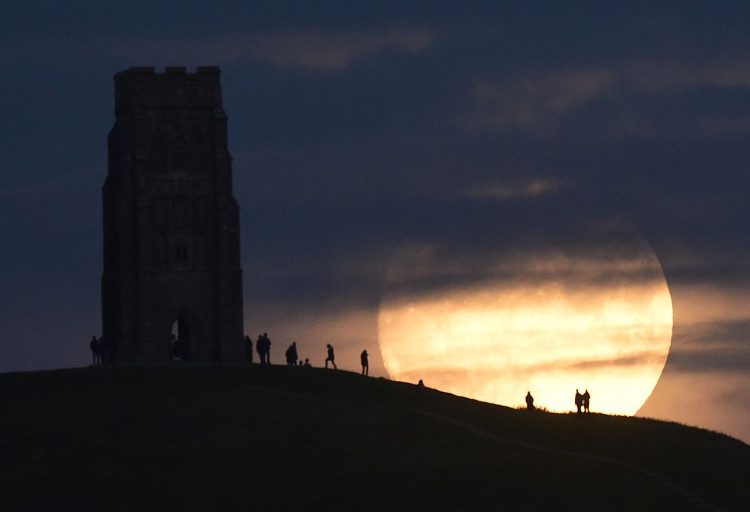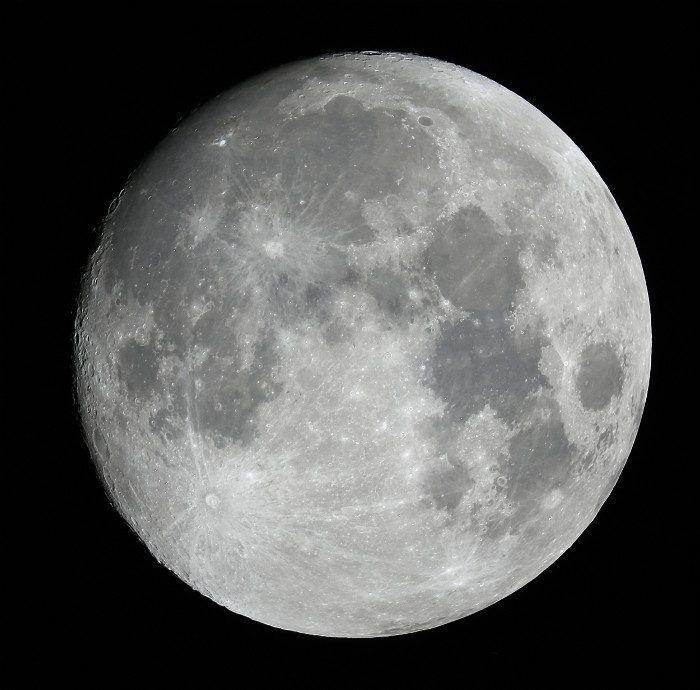The Moon – the largest and brightest object in the night sky has fascinated and inspired humanity for centuries. Below are some intriguing facts about Earth’s only natural satellite.
Here are some little-known facts about Earth’s natural satellite, including all the different names for the full moon each month and the days throughout the year when you can witness this emotional event.
How often does the Full Moon occur?
The Full Moon occurs approximately every 29.5 days. This is when the Moon is completely illuminated by sunlight.
In reality, one side of the Moon always faces the Earth, while the other side remains in darkness, so most of the time, the “full moon” will not appear completely round. Only when the Moon, Earth, and Sun align does the Moon appear perfectly full, and this alignment can lead to a lunar eclipse.
Why is the Full Moon named as such?
Early Native Americans did not keep track of time using the Julian or Gregorian calendars. Instead, tribes named each full moon to track the seasons and lunar months.
Most names of the full moon relate to an activity or event occurring at that time in each locality. However, this was not a standardized system. Tribes tended to name and count the lunar cycles differently. For example, some tribes counted four seasons in a year while others counted five. Some defined a year as 12 lunar cycles, while others defined it as 13.
According to the Farmer’s Almanac, American colonists adopted some Moon names and applied them to their calendar system, which is why they remain in use today.

Tribes named each full moon to track the seasons and lunar months.
January: Wolf Moon
The full moon in January is named for the time of year when villagers often heard the howling of hungry wolves. Another name for it is Old Moon.
Full Moon date: January 12.
February: Snow Moon
Historically, February has always been the month with the heaviest snowfall in the U.S., thus the full moon is called the Snow Moon. It is also known as Hunger Moon because hunting is difficult in heavy snow conditions.
Full Moon date: February 11.
March: Worm Moon
As temperatures warm, earthworms begin to appear, and birds start to search for food. It is also referred to as Sap Moon, Crow Moon, and Lenten Moon.
Full Moon date: March 12.
April: Pink Moon
The full moon in April is called the Pink Moon, but don’t expect the Moon to turn pink. In fact, it is named after the pink wildflowers that bloom in the U.S. and Canada in early spring.
The Moon, visible for about 7.08 days, is also known as Egg Moon due to spring being the season of reproduction and egg-laying. Some coastal tribes call it Fish Moon because it appears when herring swim upstream.
This moon is significant as it sets the date for Easter, which falls on the first Sunday after the Pink Moon. This year, Easter is on Sunday, April 16. The Pink Moon also marks the beginning of the Jewish Passover.
Full Moon date: April 11.
May: Flower Moon
Spring officially begins in May when colorful flowers bloom. This Moon is also known as Corn Planting Moon, as it is the time for planting crops. It is also called Bright Moon because it is known to be the brightest moon of the year. Some refer to it as Milk Moon.
Full Moon date: May 10.
June: Strawberry Moon

Strawberry Moon at Glastonbury Tor in June 2016.
The full moon in June is named for the beginning of strawberry harvesting season. Other names include Rose Moon or Hay Moon, as hay is also harvested during this time.
This moon occurs in the same month as the summer solstice, the longest day of the year (June 21), when we can enjoy about 17 hours of daylight.
Full Moon date: June 09.
July: Thunder Moon
Named after a common summer phenomenon: thunder. It is sometimes called Full Buck Moon as it is when young bucks begin to grow their new antlers.
Full Moon date: July 09.
August: Sturgeon Moon
North American tribes often catch sturgeon during this month, but it is also when grains and corn are harvested, thus the full moon in August is also called Grain Moon.
Full Moon date: August 07.
September: Harvest Moon

Harvest Moon.
September is the time when most crops are harvested. The Moon also illuminates farmers working at night. Some tribes also call it Barley Moon.
The Harvest Moon sometimes occurs in October – this is when the full moon falls close to the autumnal equinox (the beginning of fall in the Northern Hemisphere, when the Sun is directly above the equator, and begins its descent southward. The equinox typically occurs around September 22 to September 24).
Full Moon date: September 06.
October: Hunter’s Moon
The light of this moon helps hunters track their prey before entering the barren winter months. It is also known as Blood Moon.
Full Moon date: October 5.
November: Frost Moon
This is the time when the cold winter begins to knock on the door.
It is also known as Beaver Moon as this is when Native Americans would set traps for beavers before the waters start to freeze.
Full Moon date: November 4.
December: Cold Moon

Cold Moon on December 13, 2016, in Cornwall.
The name of the full moon in December comes from the frigid winter days with long, darker nights. Christmas is just a few days away, so this is considered the Moon before Christmas.
Full Moon date: December 3.
What is a Supermoon?
A Supermoon occurs when the Moon moves to the point in its orbit closest to Earth (perigee), making it appear larger from Earth.
Moreover, when the Sun, Earth, and Moon align perfectly at the moment the Moon is at perigee, the Moon will appear brighter and significantly larger when viewed from Earth, resulting in the phenomenon known as Supermoon.
Compared to the Moon at its farthest distance from Earth (apogee), the Moon appears 30% brighter and 14% larger when viewed from Earth during a Supermoon event.
Supermoons can also lead to the phenomenon of super tides (higher than normal tides).
There were four Supermoons in 2017, although three of them were not visible. Only one Supermoon was observed around December 2 to December 3.
“Once in a Blue Moon”
This famous phrase has a connection to the moon, doesn’t it? Yes, it does. The Blue Moon phenomenon is rare, and we use this idiom to refer to something that rarely happens.
A Blue Moon is a Western concept that refers to a full moon that does not align with a calendar month. Typically, a calendar year has twelve full moons, coinciding with one full moon per month. However, since a calendar year is about 11 days longer than a lunar year, these full moons gradually accumulate to create an additional full moon every two or three years (specifically, a cycle of 2.7154 years or 7 times in a 19-year Metonic cycle).
Human Exploration of the Moon
To date, only twelve people have walked on the Moon, all of whom are American, including Neil Armstrong, the first person to step on the Moon in 1969 during the Apollo II mission.
The last time humans visited the Moon was in 1972 when Gene Cernan participated in the Apollo 17 mission.
While Armstrong was the first to walk on the Moon, Buzz Aldrin was the first to … use the restroom there. While millions watched the live television broadcast of the Moon landing, Aldrin had to relieve himself in a special tube equipped in his spacesuit.
When astronauts removed their helmets and walked on the Moon, they detected a strong odor that Armstrong described as “wet ash in a fireplace,” while Aldrin likened it to “burnt gunpowder.” This was the scent of lunar dust on their boots.
The mineral armalcolite, discovered during the first lunar landing and later found at various locations on Earth, was named after the three Apollo 11 astronauts: Neil Armstrong, Buzz Aldrin, and Michael Collins.
Approximately 600 million people watched the Apollo 11 mission live on television. This set a world record until 1981 when 750 million viewers tuned in to the wedding of Prince Charles and Lady Diana Spencer.
Before Apollo 11 launched, many considered the worst-case scenario for the three astronauts’ journey. One of the experts who wrote speeches for U.S. President Richard Nixon prepared a speech titled: “The Moon Disaster.”
The speech began with the line: “Fate has decided that the Moon explorers rest eternally there in peace.” The plan was that if the attempt to leave the Moon failed, the ground control would sever all communication with the lunar module, leaving the astronauts’ lives to fate. However, they returned safely to Earth, ushering in a new era of space exploration for humanity.
Additional Information About the Moon:
|





















































